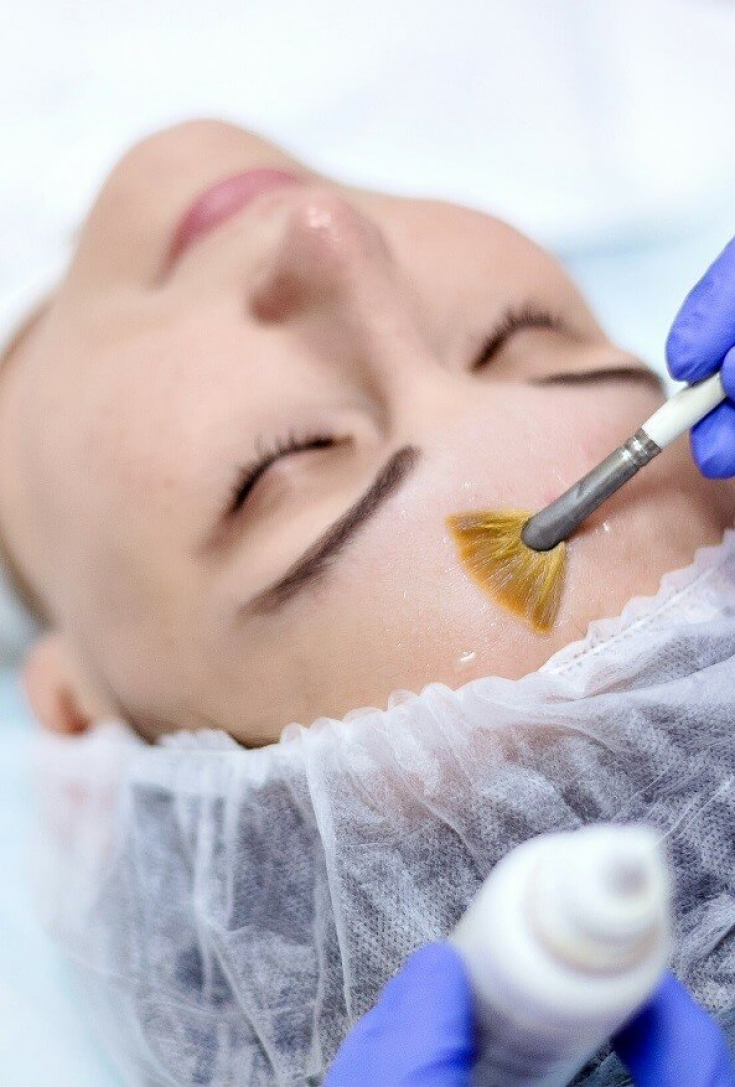For chemical peeling, a large number of different acids are used, each of them has unique properties and in a certain way affects the skin.
By choosing the right acid for a particular problem, you can achieve excellent results in improving the quality of the skin. On estet-portal.com read about what acids are used for skin peeling, what effects they can achieve, and what factors are important to consider when choosing a peeling in order to increase its effectiveness and security.
- The main types of acids for chemical peeling
- What determines the effectiveness of chemical peelingha
The main types of acids for chemical peeling
1. Glycolic acid has the smallest (among AHA) molecular weight, which allows it to penetrate deep into the skin and stimulate the synthesis of collagen, elastin and glycoproteins, as well as restore the lipid barrier.
It provides:
- pronounced rejuvenating effect;
- the fight against chrono- and photoaging;
- Improve the barrier function of the skin.
Acid Peeling: The Anatomy of a Chemical Peel
2. Lactic acid stimulates the synthesis of collagen, elastin and glycoproteins, has high moisturizing properties, restores the lipid barrier.
Lactic acid is used for:
- combating the manifestations of chrono- and photoaging;
- increase hydration;
- Improve the protective function of the skin.
3. Mandelic acid has a large molecular weight, so it penetrates the skin more slowly. This acid stimulates the synthesis of collagen, elastin and glycoproteins, has a comedolytic and bactericidal effect.
Its features include:
- minimal irritation;
- the fight against the manifestations of chrono- and photoaging;
- normalization of the secretion of the sebaceous glands;
- depigmenting action.
What can a chemical peel do in skincare
4. Salicylic acid has lipophilic properties, due to which it penetrates into the pores.
Salicylic acid has keratolytic, comedonolytic, anti-inflammatory and antibacterial effects. Provides normalization and control of oily and acne-prone skin.
5. Citric acid has a large molecular weight, resulting in slower penetration into the skin. It stimulates the synthesis processes in the skin, has antioxidant and bactericidal properties.

Citric acid guarantees:
- minimal irritation;
- the fight against the manifestations of chrono- and photoaging;
- whitening action;
- antioxidant effect.
6. Kojic acid inhibits tyrosinase activity, has antioxidant properties, and also has anti-inflammatory and bactericidal properties.
Kojic acid produces:
- persistent depigmenting effect;
- prevention of melanosis;
- antioxidant effect.
Bright, young, fresh: features of peeling with glycolic acid
7. Pyruvic acid has a small molecular weight, which indicates its high permeability. It stimulates the synthesis of collagen, elastin and glycoproteins, inhibits the activity of tyrosinase, thanks to rya lipophilic properties penetrates into the pores and has a comedonolytic and bactericidal effect.
What determines the effectiveness of chemical peeling

The strength of a chemical peel solution on the skin depends on three factors:
- acid concentration in solution in %;
- type and properties of the acid;
- acidity (pH value) of peeling: the lower the pH, the deeper the preparation penetrates the skin.
High % acid at low pH - give aggressive peeling in combination.
The value pH has more weight than the percentage of acids. For comparison, a cleaner with 80% acid and a pH of 4.5 is weaker than a cleaner with 10% of the same acid and a pH of 1.3. But at the same time, very low pH values lead to excessive skin irritation.
A less aggressive effect makes it possible to fully reveal the full potential of acids, and to obtain, first of all, a stimulating effect on the skin.
Read the most interesting articles in Telegram!
It is also important to consider its consistency when choosing a peel. Most peels available on the market – these are liquid peels, with a consistency close to that of water.
This does not affect performance, but is an additional inconvenience as it spreads, risking contact with eyes or other sensitive areas, which can cause chemical injury.
Gelpeelings have a more advanced formulation that contains ingredients that increase viscosity. The gel form provides easier application and prevents the peel from spreading uncontrollably.
More useful and interesting information on our channel on YouTube:







Add a comment